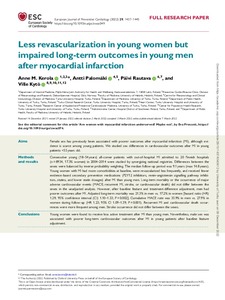Less revascularization in young women but impaired long-term outcomes in young men after myocardial infarction
Kerola Anne M; Palomäki Antti; Rautava Päivi; Kytö Ville
https://urn.fi/URN:NBN:fi-fe2022121371227
Tiivistelmä
Background: Female sex has previously been associated with poorer outcomes after myocardial infarction (MI), although evidence is scarce among young patients.
Aim: We studied sex differences in cardiovascular outcomes after MI in young patients <55 years old.
Methods: Consecutive young (18-54 years) all-comer patients with out-of-hospital MI admitted to 20 Finnish hospitals (n = 8934, 17.3% women) in 2004-2014 were studied by synergizing national registries. Differences between sexes were balanced by inverse probability weighting. The median follow-up period was 9.1 years (max 14.8 years).
Results: Young women with MI had more comorbidities at baseline, were revascularized less frequently, and received fewer evidence-based secondary prevention medications (P2Y12 inhibitors, renin-angiotensin signaling pathway inhibitors, statins, and lower statin dosages) after MI than young men. Long-term mortality or the occurrence of major adverse cardiovascular events (MACE; recurrent MI, stroke, or cardiovascular death) did not differ between the sexes in the unadjusted analysis. However, after baseline and treatment-difference adjustment, men had poorer outcomes after MI. Adjusted long-term mortality was 21.3% in men vs. 17.2% in women (HR 1.29; 95% CI 1.10-1.53; p=0.002). Cumulative MACE rate was 33.9% in men vs. 27.9% in women during follow-up (HR 1.23; 95% CI 1.09-1.39; p=0.001). Recurrent MI and cardiovascular death occurrences were more frequent among men. Stroke occurrence did not differ between sexes.
Conclusions: Young women were found to receive less active treatment after MI than young men. Nevertheless, male sex was associated with poorer long-term cardiovascular outcomes after MI in young patients after baseline feature adjustment.
Kokoelmat
- Rinnakkaistallenteet [27094]
